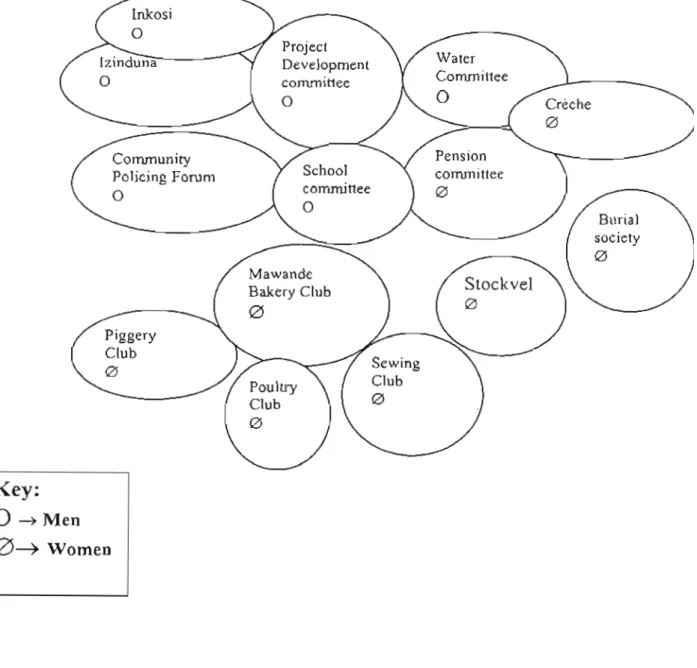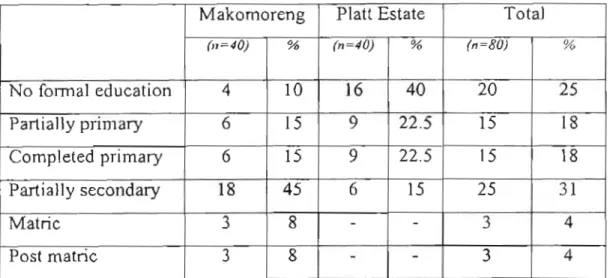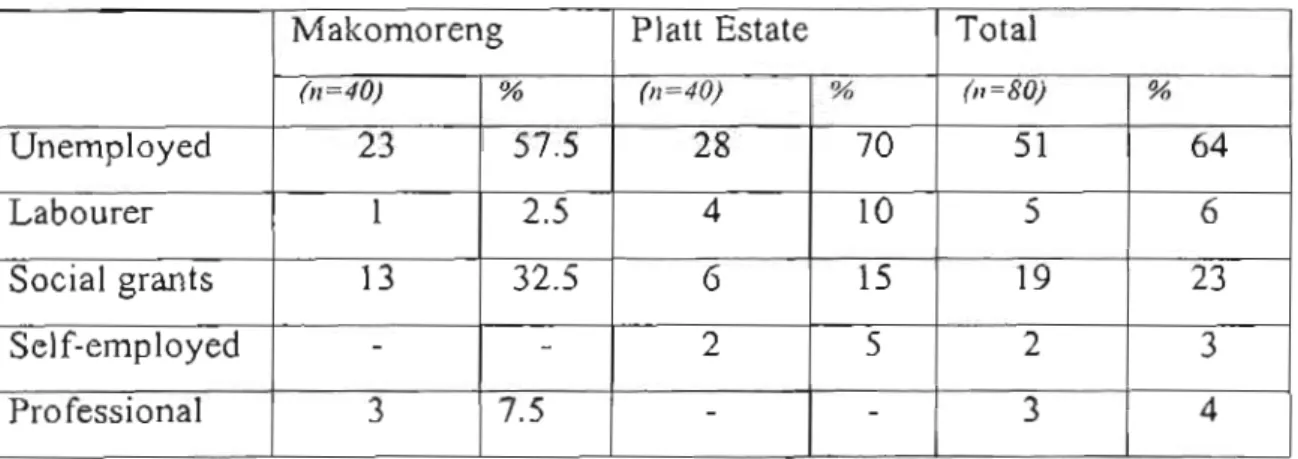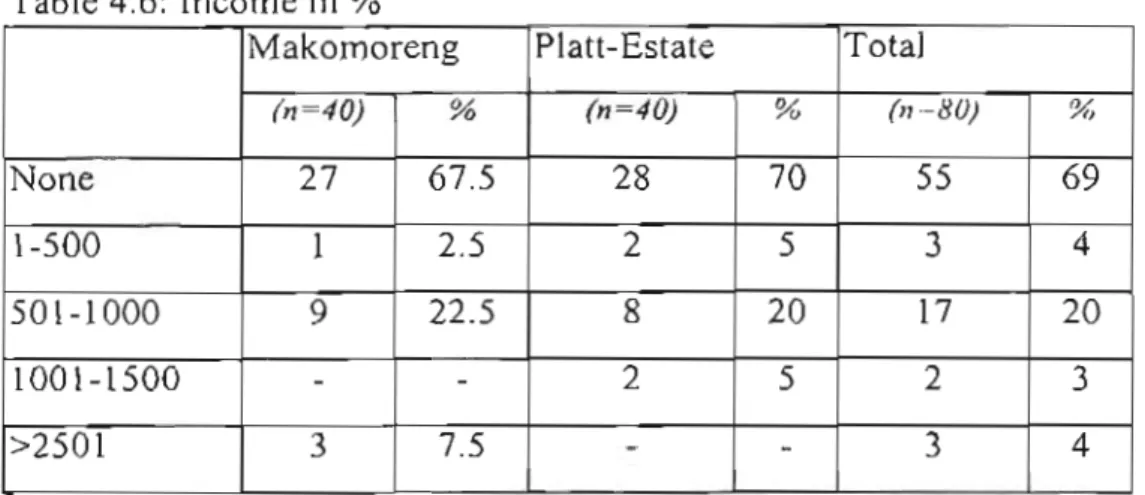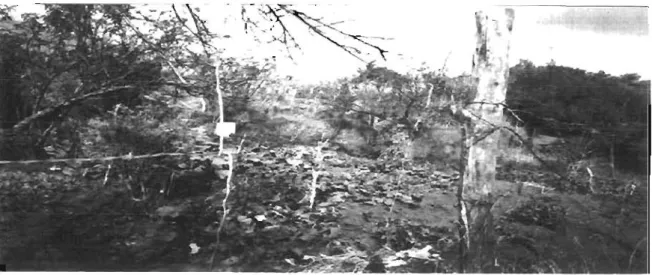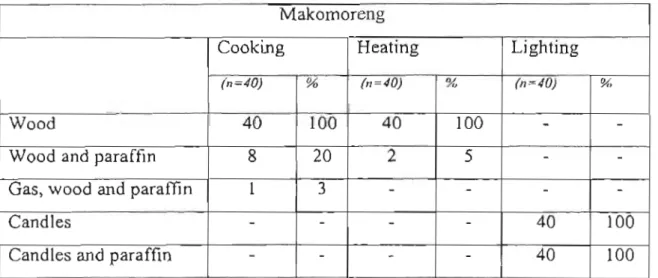Above all, I would like to thank Musa Khanyile and Noel Chellan, staff members of the Department of Geography. 1 0 Responsibility for collecting water (Makollloreng) 82 Table 4.11 Responsibility for collecting water (Platt Estate) 83 Table 4.12 Primary sources for cooking, heating and lighting (Makomoreng) 85 Table 4.13 Primary sources for cooking, heating and lighting ( Platt Estate) 86 .. Table 4.15 Reasons for preferring the fuel chosen 87 Table 4.) 6 Types of latrines available in both communities 88.
INTRODUCTION
Most of the women are heads of families for de [acto and de jure reasons, but they are still not well represented in the decision-making structures, while most of the load in the family is the responsibility of these poor women. The purpose of the study is to examine the use of technology by rural women and the barriers.
OBJECTIVES
GENDER AND DEVELOPMENT - A THEORETICAL FRAMEWORK
Women have little or no access to vital resources, including land and credit (Ahmed 1985; Porter, 1999). They further reveal that women produce approximately 40% to 80% of the world's food, but have access to only 3% of the land.
WOMEN AND ACCESS TO TECHNOLOGIES .1 Definitions and conceptual clarifications
For the women, the most important aspect of the project was their openness to the world. The literature shows that in many parts of the world men occupy important positions in community development structures.
MAP I: MAP OF KWAZULU-NATAL SHOWING STUDY AREAS
In Makomorengo, only 10% of respondents have no formal education, while in Platt Estate, 40% are illiterate. Twenty-three percent of respondents (33% in Makomoreng and 15% in Platt Estate) rely heavily on social supports (pensions and child support). Six percent of respondents (3% in Makomoreng and 10% in Platt Estate) are employed as laborers in a nearby town.
Only 5% of Platt Estate respondents are self-employed, while in Makomorengo only 8% of respondents are professionals. In Makomorengo, some respondents revealed that the women there developed a bakery.
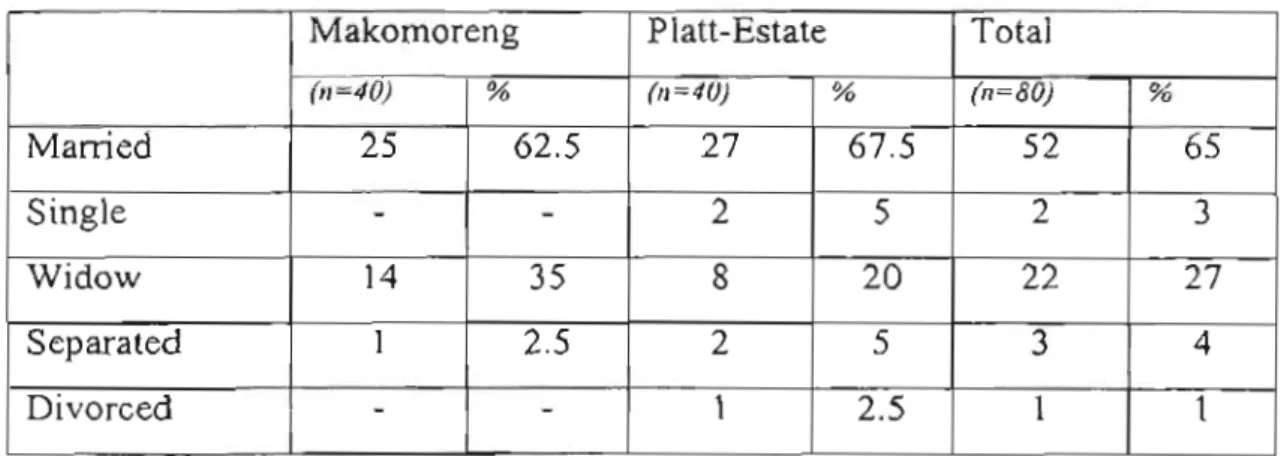
GENDER DYMNAMICS
Both tables show that women are primarily responsible for fetching water, collecting firewood and taking care of children. There is ample evidence that women take on a large share of household tasks. The respondents indicated that they are members of the community, but men are hired to build the house.
Mainly women do most of the building, as the table above shows, 95% of the respondents surveyed said that they build the roof with the help of boys. Respondents pointed out that no one teaches them these methods of building the house, but they only learn by seeing other family members and neighbors.
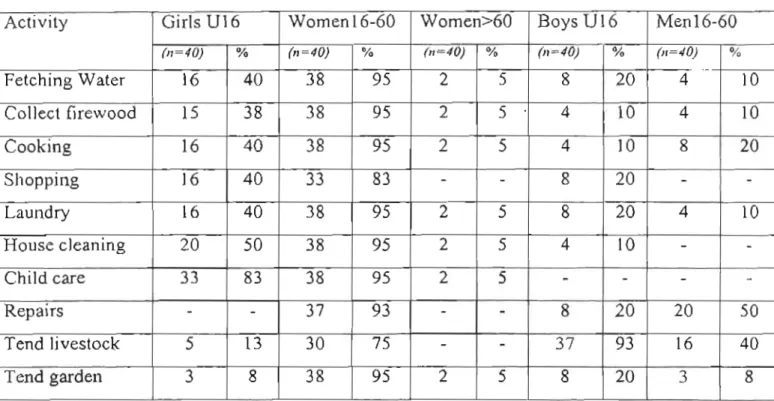
LAND
LIVESTOCK
It is also important to note that most of the respondents who own larger livestock are widows. Although the data show that most respondents keep livestock for household purposes, other respondents illustrated that they sometimes sell to generate income when conditions within the household deteriorate. Respondents indicated that they use medicinal and indigenous methods to control disease problems.
Indigenous methods include using crushed aloe leaves in water, inhalation mixed with water to control chicken disease, and motor oil used on animal wounds. Respondents in both communities indicated that they make traditional items from animal skins, some sell them and others use them as small mats, while others throw them away.
AGRICULTURAL ACTIVITIES
Twenty-five percent of respondents (20% in Makomoreng and 30% in Platt Estate) indicated that they were not aware that such organizations exist in the area. Fifty percent of respondents (55% in Makomoreng and 45% in Platt Estate) stated that great women participate in stokvels because it is the only way. Some of the respondents pointed out that there are obstacles or limitations that prevent them from participating in community projects, such as busy with housework.
Some respondents stated that they were sometimes bypassed by development activities because they were not well informed when things were happening in the area. In the second chapter, the researchers mentioned that one of the reasons that prevent women from participating in development activities is that they are mostly tied to domestic chores.

COMMUNITY DEVELOPMENT STRUCTURES
Seventy percent are involved in the burial societies, as mentioned earlier, this is the way rural women function to fight against difficulties. Fifty percent are affiliated with the water committee and respondents further indicated that this committee played a crucial role in the installation of the water used in the community. Some of the problems facing the agricultural committee in Makomoreng are that they lack food and income that will be used to progress the pig farming they have started.
58 percent are involved in the funeral committee and 55 percent are in the religious women's group. In the development project committee, the percentage of women's affiliation in both communities IS very low, being 5% in Makomoreng and 10% in Platt Estate.
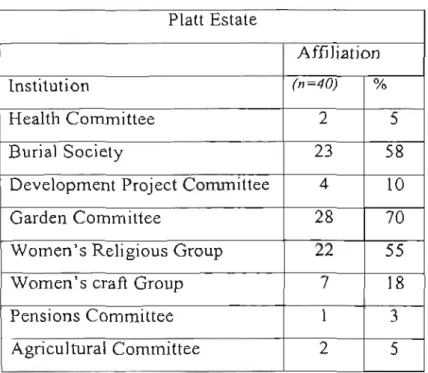
PROVISION OF LOCAL SERVICES
They stated that the police station will help them as they have problems with cattle theft. This is why they have trouble reporting urgent criminal cases to the police, if there is one in the community, reporting and action will be much faster. A community hall would be essential when the community would meet, and it would also be helpful to retirees on sunny and rainy days.
The availability of the high school in the community would help the disadvantaged children with parents who cannot afford to send them to other schools. They suggested that the hall would be an ideal place for calling meetings and a meeting place to collect their pension payments.
OFF FARM ACTIVITIES
However, few of the respondents interviewed said they brew beer to sell it. Fifty-three percent of respondents in Platt Estate and 13% in Makomoreng stated that they make mud bricks. Respondents in Platt Estate, where the use of mud bricks is common, stated that they sometimes hire other community members to make the bricks.
Eighty-three percent of respondents in Platt Estate indicated that they make traditional jewelry such as beaded bracelets and necklaces. In Makomoreng, 12% of respondents pointed out that they have already started pigging, but they do not have food to feed them.
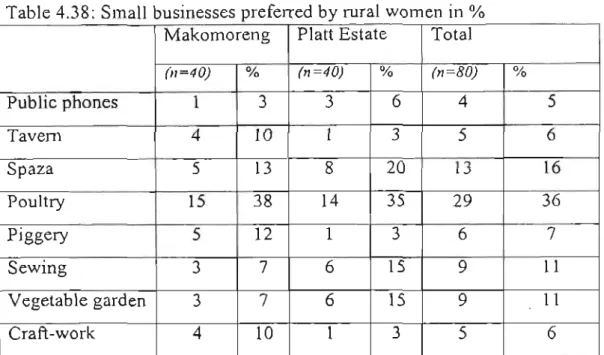
WOMEN AND TECHNOLOGY Table 4.39: De finitions of technology in %
Thirty-three percent of respondents in Makomorengo further stated that they make clay vessels. Thirty-two percent (45% in Makomoreng and 20% in Platt Estate) of respondents indicated that they use both fertilizers when planting because they need to produce a higher yield. Only 20% of respondents (15% in Makomemg and 25% in Platt Estate) indicated that they occasionally use chemical pesticides.
Twenty-two percent of respondents (17% in Makomoreng and 27% in Platt Estate) said they use bags when storing their crops. Twenty-eight percent of respondents (23% in Makomoreng and 33% in Platt Estate) said that they use old water troughs for birds to lay their eggs.

INFORMATION COMMUN ICATION TECHNOLOGY
As mentioned in the second chapter that mobile phones play a big role in the flow of information, women are able to get ideas about what is happening with their relatives in different parts of the world. Platt Estate respondents found that to get information from government officials who are resolving the land issue with local people, mobile phones are the only means by which they are informed. Respondents stated that mobile phones also help them when they want to contact extension services as they usually look for them when they need help.
Although the respondents have mentioned that they have seen a computer, they do not know how to use it because they are not familiar with any package.
HEALTH TECHNOLOGY
They further claimed that traditional medicine is commonly used as there are no clinics and doctors available in the area. It has been mentioned before that in Makomoreng there is very little transport as there is only one bus that goes to town in the morning and returns in the evening, so when there are emergencies people experience difficulties. There are no other restrictions except in the gathering of certain trees that are not touched in summer because they are dangerous as they absorb lightning.
The respondents claim that the absence of health facilities in the areas perpetuates the diseases such as ulcers because affected children do not receive any treatment and the disease easily spreads to other family members. Respondents indicated that they have problems with back pain and usually suffer from headaches.
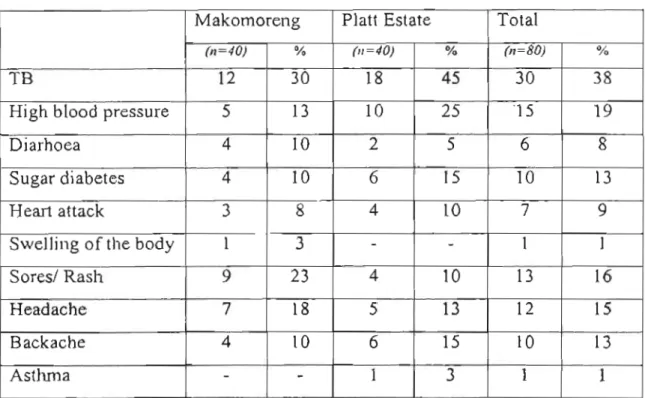
GENERAL
Six percent of respondents (3% in Makomoreng and 10% in Platt Estate) indicated that they also face the maintenance problem because there are no technicians nearby. Thirty-eight percent of respondents (45% in Makomorcng and 33% in Platt Estate) indicated that the biggest problem associated with using technology is not having land on which to freely conduct their activities. In both communities, respondents indicated that they do not have enough time to learn to use other technologies.
Respondents in both communities state that they use their heads when transporting the product and input. In Makomoreng where the soils are not good, respondents mentioned that they get better yields when using chemical fertilizers.
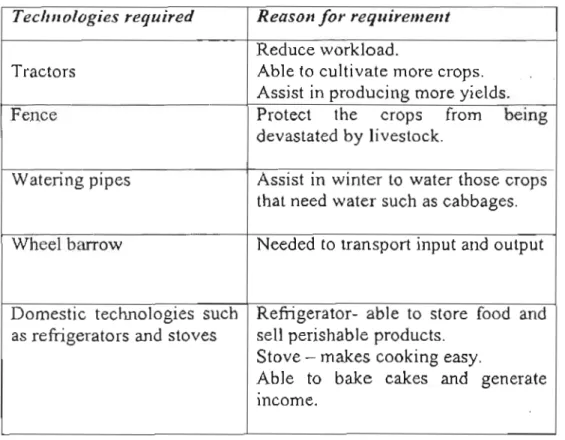
MENi AL MAP¥\NG OF MAKOMORENG
MENTAL MAPPING OF PLATT ESTATE
- CONCLUSION
- SUMMARY OF MAIN ARGUMENTS
- RECOMMENDATIONS
- C ONCLUDING REMARKS
- SOCIO-DEMOGRAPHIC PROFILE I COMMUNITY DETAILS
- SOCIO - ECONOMIC PROFILE I WATER
- SANITATION
- FUEL
- EDUCATION
- S ADULT BASI C EDUCATION AND TRAI NI NG
- TECHNOLOGY
- DOMESTIC-RELATED TECHNOLOGY
In light of the literature review, conceptual framework and data analysis in the previous chapters, general conclusions on women and access to technologies are presented. Both the public and private sectors must take the initiative in offering the services. I 996) Land, labor and livelihoods in rural South Africa: local and rural livelihoods in the Western Cape Durban: Indicator Press.
1996) Land, Labor and Livelihoods in Rural South Africa: An Analysis of the Position of Women in Agricultural Development in the Northern Province Durban: Indicator Press. In komunlly and lick, if any member of the household is connected with such institutions).
